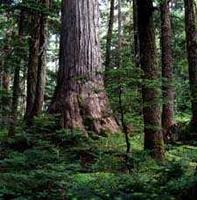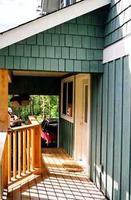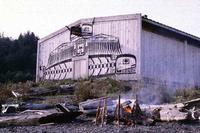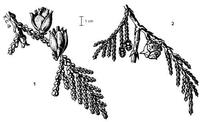Cedar
CEDAR tree is an evergreen belonging to the cypress family. The western red cedar (Thuja plicata) occurs along the coast and the western slopes of the ROCKY MTS and is distinguished by scale-like needles. At high altitudes it is stunted in size, but in other areas individual trees are gigantic. The largest known specimen in Canada, 59.1 m tall and 6 m across, overlooks Cheewhat Lk in PACIFIC RIM NATIONAL PARK RESERVE on the west coast of VANCOUVER ISLAND. The yellow cedar (Chamaecyparis nootkatensis), also known as the cypress, is smaller and occurs in cold, wet areas of higher elevation. The name refers to the light, creamy colour of the soft, pungent wood. Coastal FIRST NATIONS used the yellow cedar for carving and making paddles, and prepared the soft inner bark for use in weaving clothing. It is a very long-lived species: one tree cut down on the Sechelt Peninsula was calculated to be almost 1,700 years old and there are a few specimens still standing in CYPRESS PROVINCIAL PARK that are over 1,200 years old. Western red cedar is highly valued in foreign lumber markets, especially Japan. Aboriginal people used it for TOTEM POLES, dugout CANOES and houses, as well as many types of containers and in weaving. Because the wood is resistant to decay it has been used commercially for BOATBUILDING and in many types of wood construction. In 1988 the western red cedar was named BC's official tree. See also ARCHITECTURE, ABORIGINAL; FOREST PRODUCTS.
Reading: Nancy J. Turner, Plants in British Columbia Indian Technology, 1979.




